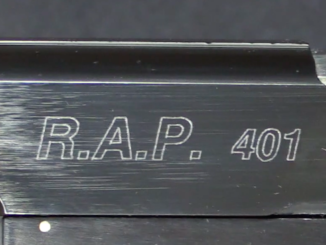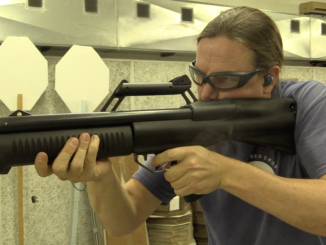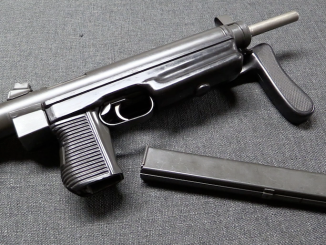In the brief couple of years between the election of a new black-majority government in South Africa in 1994 and the dissolution of the Musgrave company, it attempted to produce a new 9mm pistol to sell to the burgeoning market of black South African citizens buying handguns. Ownership of pistols by black citizens had been legal under apartheid, but was (not surprisingly) quite uncommon – this began to change in 1994. The most popular pistol at the time was the Norinco 213 Tokarev in 9x19mm, which was available in large numbers and at very low cost.
To compete against this, Musgrave designed a simple blowback, polymer framed pistol chambered for 9x19mm using Beretta 92 magazines (which Musgrave had a large supply of, being the license Beretta distributor in the country). The gun was extremely simple, held together with a handful of screws and using a single action only hammer-fired mechanism. It was a commercial flop, however – unable to match the quality and price combination of the Tokarev and only about 500 were made in 1995 and 1996.




“using Beretta 92 magazines”
Clever approach. Not only because they were available at hand, but also because designing properly working magazine might be more complicated that it looks, especially if it is staggered column design. Also it mean bigger capacity than Norinco automatic pistol.
I am wondering: how did Musgrave adverts of that era looked liked? Did they highlighted big capacity? Did they refer to their automatic pistol simply as Musgrave 9mm or did they used some “cool” name?
This is actually brilliant. For an handgun made to be inexpensive, it’s so much more elegant than an Hi-Point.
It only needs a simpler disassembly method (not really difficult to implement) and a better trigger (there is no treason for it to be worse than any semiauto SA hammer trigger, it’s only a question of specs and assembly).
Where do you find some of these guns?
Thank you sir for all the hard work you do to bring these videos to the net. Also the way you make information easy to understand and well presented Makes them easy to listen to these.
Good job sir
That is really cool
OK, I’d much prefer a Chinese 9mm Tokarev… but,
The two (clam) shell plastic handle is cool
The slide guided by the barrel, the barrel mounting lug and the yoke at the back. That’s Nambu’s brilliance!
The black population really did need guns. Even in the middle to late two thousands when I was working in S’frica, the local paper in the small town in kzn was full of murders every week!
One guy was believed to have been killed for his shoes! Another for his car radio!
And at the time I was there, cops were going postal on their families and their colleagues with their issue pistols. Strangely enough, thosee mass shootings never made the lamestream news anywhere else in the world.
They still do.
Totally OT
Ian, I think that FW is being censored on airstrip one
I’ve been getting lots of timeouts and site not founds.
I’ve tried to post comments multiple times and failed.
I’ve just got a VPN and the problems have disappeared.
My mobile provide is EE
The usual wifi I use is Vodafone
Both give problems with FW.
“… timeouts and site not founds.”
Me too. Also, had couple of comments cancelled just before release.
Something “new” is up; not necessarily censorship. Maybe worse 🙂
Try flying onto a remote jungle airstrip.
Site is pretty buggy lately, wrote a lenghty comment and get a freaking timeout, grrrr.
With opening on mainpage articles also
Fascinatingly simple design. As already pointed out with similarites to Nambu’s designs. The spring wrapped around the barrel is classic PP or PMM. I think a slightly modernized version made from a one-piece injection molding could fit the cheap useable pistol market. Certainly looks better than a HiPoint.
But I personally do not trust blowback 9 mm Parabellum pistols. .380 ACP or at max 9 Makarov. Heck, 9 Makarov was developed as the strongest possible in a blowback pistol.
addendum: I would convert it to DAO and leave out the safety. Simplified and better useable as self-defence gun! 🙂
There should be a research to determine is it better to have SAO that will be theoretically badmouthed for defense practicality (which 98% of users or more, will never use it for) or DAO which will get HUGE amount of range hate, like vp70 did with its staple gun trigger pull.
But maybe there is no winner in that choice.
…Or is it possible to design DAO gun with nice trigger pull?
Maybe to implement some gears or levers system, force multiplicators.
Almost any 9mm SMG is a blowback design. They are ultra secure. There is really no problem in shooting 9mm Parabellum in a blowback design. It’s only a question of weight of the bolt/slide.
The 9mm Browning Long, 9mm Glisenti, 9mm Ultra, 9mm Makarov… (power-wise they are all in the same ballpark) have been deemed to be the most powerful 9mm cartridges that can be safey shoot in a pistol design WITHOUT WEIGHT DISADVANTAGES. The Astra 600, for example, is a safe blowback 9mm parabellum pistol, but it’s heavier than a breechlock design of the same years.
Yes, but a SMG is not a pistol. 9 Para pistols have either been really heavy and/or iffy.
Nopnetheless I would like to see it in action and an opinion on how it handles.
As said, problem is not with creating automatic pistol firing 9×19 Parabellum cartridge balanced for that particular cartridge, but that unlesss some trick would be used, it would require unpleasantly big amount of force for racking.
JO.LO.AR https://guns.fandom.com/wiki/JO.LO.AR. although not offered in 9×19 Parabellum (so far as I know) was available in similar 9×23 Largo, used blow-back principle and have palanca (which could be named lever from mechanical standpoint of view) meaning that not only it can be operated one-handed, but that less strain is required than when directly pulling slide.
As side note, even 7,62×25 Tokarev cartridge could be harnessed into blow-back automatic pistol see Балтиец https://greftung.livejournal.com/2773.html
14 examples were made in besieged Leningrad, Walther PP inspired, mass without cartridge 1100 g, capacity 8, barrel length 129 mm.
During World War One, the Dreyse M1910 in 9 x 19mm, originally designed by Louis Schmeisser for German police as a less-expensive alternative to the Parabellum pistol, used a top lever to disconnect the breechblock from the powerful recoil spring to reduce the effort needed to rack the action.
https://www.forgottenweapons.com/dreyse-1910-an-attempted-military-9mm-pistol/
The only problem was that with wear, the lever latch could weaken, which would allow the lever to “bounce” on recoil, also disconnecting the breechblock from the recoil spring. This meant that the breechblock came back very fast and sometimes departed the frame- right in the shooter’s face.
as a general rule, rounds like the 9 x 20SR Browning (“9mm Browning Long”), 9 x 18 Makarov, or the Italian 9 x 19mm Glisenti (same cartridge case as the 9mm Parabellum but weaker powder charge giving ballistics in the range of the .38 Special) are about the upper limit for a safe blowback pistol action without an excessively heavy slide, high-poundage recoil spring, or etc.
cheers
eon
This pistol is vaguely similar to the Ruger 22/45 and KelTec has been using clamshell receivers on some of their firearms like the PMR30 for a while now. Considering that both of these handguns are retailing for over $400 & you can get a Tokarev for half that, I can’t imagine that even back then this pistol was that great of a deal.
I think it would also be way more expensive than a Hi-Point, as casting big globs of zinc is cheaper than even the minimal machine operations on the Musgrave.
But today you could manufacture it in a CNC instead of risking a casting, that can go wrong. Just chuck a bar of steel into the machine, pull out a slide. so would really be a tossup in the end I think.
Both of the aforementioned handguns are considered “cheap”. I believe the Ruger’s receiver is made from tubing & the KelTec is mostly polymer. Both of these companies are established & have recouped their investment in tooling, yet their guns are still running $400+.
Seems a pistol constructed intentonally badly by a competent pistol designer capable to make more better, usable samples… Pity…
Since it was made for Black Market, it might have no measure for shooting comfort and safety… It could be made as working in simple blowback, no disconnector, no strong fixing elements… Using screws even for barrel bushing would be quite appropriate…
No matter using a fixing screw at weakest point of plastic trigger guard… Look at those toy pistols… Nearly use the same construction… They work!…
…
Made for Black population, not “market”… but funnily all you said could apply there, and also especially to their fellow gangbanger brothers overseas
Racist much?
Not living among such population so I never could or will be.
Rassenverrater much?
Any blowback pistol with 10 cm barrel lenght might be considered as safe even with 250 gram slide weight and if brass cases are used, the bolt weight might be even lesser.
The fundamental purposes of using breech locks in pistols are, getting the maximum performance from the rounds used, shooting comfort, preventing gun and shooter fatique and providing easiness at follow up shoots. For a gun of limited usage for so called subclassified persons these features might be sacrificed.
I have seen zamak Beretta F92 blowback pistols made in quantity and sold to the countries needing cheap pistols made by ignored, untrained manufacturers. This might be tolerated to a level since the makers having no knowledge at the gun technology… But for the trained, experienced, well educated makers, this kind of guns should be a shame of gun culture since they could be made safer, more comfortable and more practical with the same costs… IMHO.
In short, such pistols fall into the category of a “polymer one-shot”, a type of handgun described in the Cyberpunk 2020 RPG published by R. Talsorian Games in the early 1990s.
A simple blowback pistol with an aircraft-aluminum action (packaged like a Tokarev), usually a ceramic barrel, an aluminum or mild steel “tube” forming the upper receiver, cast metal breechblock, and a plastic frame and magazine, both injection moulded from ABS or even polystyrene (yes, the stuff plastic model kits are moulded from).
They were called “one-shots” because generally after about two or three magazines-full of ammunition had been run through them, something in the action broke, or the barrel fractured, or etc. And they sold for about 20 euros. In short, “throwaway” weapons.
The most unnerving ones were the ones that fired full-auto. Their frames tended to melt.
The trouble with science fiction is that reality keeps catching up with it.
cheers
eon
I would never ever try to fire blowback 9mm pistol with only 250g slide. Even less? Now that could be suicide pistol
The problem of designing a blowback handgun for powerful cartridges is not that much that of the safe extraction of the cartridge (a relatively lightweight slide is enough for that) but that of preventing the slide to hit the frame with enough force to damage one, the other, or both. That’s why the most “advanced” od “sucessful” designs resorted to use very heavy slides and/or very stiff recoil springs (the stiffness of the recoil spring has practically no importance in delaying the opening of the action) and/or buffer springs/recoil pads.
It has to be remembered that, in a short recoil action, the rearward movement of the slide is slowed down not only by the adjunctive mass of the barrel, but by the same “blow forward” force that the bullet is imparting to the barrel itself.
Case head separation could occur, but yes, ingenious (lol) designer of Kimball chamber ring retarded blowback .30cal pistol learned (but never perfected it) that prevention of slide in recoil slamming and shearing parts of the frame is equally important as delaying the extraction !
The Steyr GB-80 adapted the gas-delayed system of the Volkssturm Gewehr 1-5 carbine. High-pressure 9mm worked just as well as low pressure rounds, there was just a slightly longer delay in the slide cycling.
This is such a simple and “blindingly obvious” answer to the problem I’ve never quite understood why it is so seldom used.
cheers
eon
Delayed blowbacks (gas, roller, lever…), in general, work very well, but their problem is that they tend to become as complicate as breechlock designs, so why bother?
Gas-delayed tend to have heat problems too.
“This is such a simple and “blindingly obvious” answer to the problem I’ve never quite understood why it is so seldom used.”
Well, it seems to be cyclically “reinvented” and produced, but with limited success. If I am not mistaken, most recently in form of Walther CCPM2
https://www.waltherarms.com/handguns/ccp-m2/
they dubbed their variant of Gasbreme: softcoil, CCPM2 it is improved CCP (different disassembly procedure – CCPM2 do not need tool for doing it). Most reviews of that particular automatic pistol seems to be positive, but I do not know how popular in reality it is.
Thanks for the video, I was expecting it for a long time.
Could only be more satisfied if it showed firing, but who knows, maybe we will have that one day.
Im very skeptical of this barrel screws in only plastic receiver concept, I suppose it would not be very durable.
Also what does these 2 small ring screws screw into, steel or plastic ? If its plastic, then its even less durable.
These design quality issues probably contributed to eventual failure.
It had some good easy manufacturing features, like slide could be made on lathe, in 2 parts it would be even cheaper and easier, Kommando LDP style.
Id redesign the frame with steel inserts in the back and around barrel mount, and to hold the back ring with small 1 or 2 pushpins, HK style,
also make a provision to remove the slide without taking barrel screws out (if theres a room for lifting the slide and barrel muzzle end not getting in a way), or with one easily removable pin.
You have to think of that barrel’s “tail” as the frame. The screws link the frame to the plastic handle.
In the Chinese CF-98 the only thing that links the metal frame to the plastic handle is the single pin of the hold-open lever. In other designs are a pair of rolling pins. They are really not more sturdy than a pair of screws.
to me the design, in general, is sound (if the weight of the slide and the resistance of the slide and the “tail”, that’s where the slide slams at the end of the recoil run, have been well calculated).
Its a matter of time when plastic frame around the screws will start to crack, from slamming of the slide into the “tail”. No buffering spring, bad thing.
Looked up CF98, it actually has sheet metal framing that houses fcg and barrel, so its not barrel to frame direct contact, excellent modular design idea.
In much blowback designs the barrel is fixed to the frame, so it’s an integral part of it. As said, here, the “tail” of the barrel IS the frame, while the plastic part is an handle.
In the CF98 at the end of its rearward travel, the slide slams directly into the locking block, the locking block and the sheet metal frame are BOTH secured to the plastic handle via the same single pin that, this way, absorbs the entire recoil and transmits it to the handle exactly like the two screws in the Musgrave, and the plastic is even thinner.
With chinese pistol, construction is reinforced with that steel cradle, and forces distributed evenly,
in musgrave it is only structural disaster waiting to happen, plastic frame being 2 part not even properly joined does not help.
Also it looks very thin and flimsy, kinda like toy and consumer electronic plastic, not one used for guns, like they were improvising there.
They definetly should have put some kind of steel framing of cf98 fashion and around it 2 part plastic handle (if making in single piece is not doable)
The steel cradle of the CF98 doesn’t distribute the recoil evenly, because, as already said, in the CF98 at the end of its rearward travel, the slide slams directly into the locking block, the locking block and the sheet metal frame are BOTH secured to the plastic handle ONLY via THE SAME single pin that, this way, absorbs the entire recoil and transmits it to the handle exactly like the two screws in the Musgrave, and the plastic is even thinner.
There are more contact points of the cradle, abbuting the end of the frame, around safety and probably some others,
but you are free to believe it is exactly the same design quality as Musgrave and its two screws.
The safety of the CF98 is not a point of contact. Yes, the back of the sheet metal frame is in contact with a very thin part of the plastic handle (but the sheet metal is really too flymsy to take advantage of that. That thing can be easily bent by hand, that’s why the back of the plastic handle is so thin, it’s not intended to be a stressed point at all), like the back of the tail of the barrel of the Musgrave is in contact with a much more meaty part of the plastic handle of that gun.
Between the two, the Musgrave design appears to be sturdier.
“design quality” means several thing. Structutral soundness is only one of them. a pistol can be safe to use, but crude.